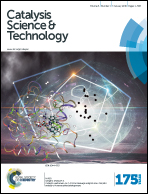Structure-controlled porous films of nanoparticulate Rh-doped SrTiO3 photocatalyst toward efficient H2 evolution under visible light irradiation†‡
Abstract
Porous films of Rh-doped SrTiO3 (SrTiO3:Rh) were prepared on glass substrates as a visible light-responsive photocatalyst panel that can generate H2 efficiently under visible light irradiation. The films were prepared by simple screen-printing using the pastes of the fine particles (ca. 50 nm) of SrTiO3:Rh (WH-particles), which were prepared via a facile water-based process, followed by calcination at 500 °C. The use of WH-particles having relatively narrow size distribution allowed us to prepare homogeneous films with controlled thickness ranging from 1 to 10 μm, along with enough mechanical strength. On the other hand, the use of SrTiO3:Rh particles (SS-particles, ca. 300 nm) prepared by a conventional solid state reaction method resulted in inhomogeneous surfaces and exposure of the glass substrates when the thickness was below 3 μm. The SrTiO3:Rh films (WH-films) consisting of the fine particles exhibited much higher efficiency for H2 evolution from methanol aqueous solution under visible light than those prepared from the SS-particles (SS-films) at each thickness. The H2 evolution rate on WH-films increased to reach maximum value at 10 μm (3.2 μmol h−1) while those on SS-films saturated at a thinner thickness of 5 μm (0.7 μmol h−1), and was confirmed to be higher than those on the suspended system with the same amounts of WH-particles. Furthermore, the addition (10–20 wt%) of the large particles to the WH-films further increased the H2 evolution rate, probably due to the light scattering with large SS-particles, by which the neighboring small WH-particles in the films can effectively absorb the scattered light and generate more H2.


 Please wait while we load your content...
Please wait while we load your content...